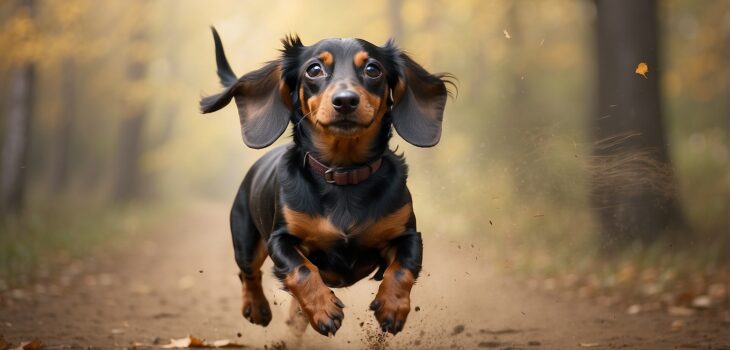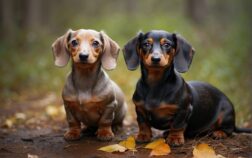Dachshunds, with their short legs and long bodies, certainly have a unique charm. However, have you ever wondered if their love for jumping could potentially impact their health? In this article, we will explore the potential effects of jumping on dachshunds and delve into whether or not it is detrimental to their well-being. So, if you’re a dachshund owner or simply curious about the health implications of this energetic behavior, keep reading to learn more.
Introduction
Welcome to this comprehensive article on the impact of jumping on the health of Dachshunds! As a proud owner of this beloved breed, it’s important to understand the unique body structure of Dachshunds and how jumping can potentially affect their health. In this article, we will delve into the anatomy of Dachshunds, common health issues they may face, the specific impact of jumping on these conditions, and provide practical tips to manage jumping and improve their overall well-being.
Anatomy of Dachshunds
Unique Body Structure
Dachshunds have a distinct body structure characterized by their long, elongated bodies, short legs, and deep chests. This unique physique gives them the ability to excel in hunting and burrowing activities for which they were originally bred. However, this anatomy also poses certain physical challenges that can affect their health, particularly their spines and joints.
Importance of Spinal Health
One of the key concerns for Dachshunds is their spinal health. Their long vertebral column and relatively short ribcage put them at a higher risk of spinal issues, including intervertebral disc disease (IVDD). Maintaining a healthy and strong spine is crucial for their overall well-being and mobility.

Potential for Injuries
Due to their body structure, Dachshunds are more prone to injuries from activities that involve jumping, such as leaping off furniture or jumping too far from high surfaces. Understanding the potential risks and taking preventive measures can greatly minimize the chances of injury and ensure a long and healthy life for your furry companion.
Common Health Issues in Dachshunds
When it comes to Dachshunds, there are several health issues that they are prone to. It’s important for owners to be aware of these conditions in order to recognize any potential symptoms early on and seek appropriate medical attention. Let’s explore some of the common health issues observed in Dachshunds.
Intervertebral Disc Disease (IVDD)
IVDD is a spinal condition that affects the discs between the vertebrae of the spine. The discs can degenerate or become herniated, causing irritation or compression of the spinal cord and nerves. Dachshunds are particularly prone to IVDD due to their long spinal structure.
Hip Dysplasia
Hip dysplasia refers to abnormal development or malformation of the hip joint. This condition can lead to pain, lameness, and reduced mobility. While hip dysplasia can occur in various dog breeds, Dachshunds may be predisposed to it, especially if they are overweight or engage in excessive jumping.

Luxating Patella
Luxating patella, also known as a dislocated kneecap, occurs when the patella (kneecap) slips out of its normal position. This condition can cause limping, pain, and difficulty in walking. Dachshunds are prone to luxating patella, and jumping can exacerbate the problem and lead to further complications.
Osteoporosis
Osteoporosis is a condition characterized by low bone density, making the bones weak and more susceptible to fractures. While this condition is more commonly associated with aging, Dachshunds may also be at a higher risk due to their genetic predisposition and the repetitive stress caused by jumping activities.
Jumping and Intervertebral Disc Disease (IVDD)
Explanation of IVDD
IVDD occurs when the intervertebral discs, which act as cushions between the vertebrae, degenerate or become herniated. This can put pressure on the spinal cord, leading to pain, nerve damage, and potentially paralysis. The long spine of Dachshunds makes them particularly susceptible to this condition.
Impact of Jumping on IVDD
Jumping, especially from elevated surfaces or landing forcefully, can place significant stress on the intervertebral discs. The quick and jarring movements involved in jumping can increase the risk of disc degeneration or herniation, exacerbating the risk of IVDD in Dachshunds.
Risk Factors
Certain factors can increase the risk of IVDD in Dachshunds. These include genetics, age, obesity, and excessive jumping or rough play. Understanding these risk factors can help owners take appropriate preventive measures to minimize the chances of their Dachshund developing this condition.
Symptoms of IVDD
Symptoms of IVDD can vary in severity and may include pain, reluctance to move or jump, weakness in the limbs, loss of coordination, and in severe cases, paralysis. If you observe any of these symptoms in your Dachshund, it’s crucial to seek immediate veterinary care as early intervention can greatly improve the chances of recovery.
Prevention and Treatment
Preventing IVDD involves minimizing activities that place excessive strain on the spine, such as jumping from high surfaces. Regular exercise, weight management, and appropriate handling techniques can help protect your Dachshund’s spinal health. If your furry friend is diagnosed with IVDD, treatment options may include conservative management, medication, or even surgery, depending on the severity of the condition.
Jumping and Hip Dysplasia
Explanation of Hip Dysplasia
Hip dysplasia occurs when the ball and socket joint of the hip fails to develop properly, leading to instability, pain, and progressive degeneration. While genetics play a significant role in hip dysplasia, excessive jumping and repetitive stress can worsen the condition in Dachshunds.
Impact of Jumping on Hip Dysplasia
Jumping can put excessive strain on the hip joints, exacerbating the instability caused by hip dysplasia. The sudden landing or jarring movements involved in jumping can lead to increased pain, joint inflammation, and potential long-term damage to the hip joints of Dachshunds.
Risk Factors
Apart from genetics, factors such as excessive jumping, obesity, and improper nutrition can contribute to the development or progression of hip dysplasia in Dachshunds. Understanding these risk factors allows you to make informed decisions to protect your furry companion’s joint health.
Symptoms of Hip Dysplasia
Symptoms of hip dysplasia may include stiffness, limping, difficulty in rising or climbing stairs, reluctance to jump, and reduced activity levels. If you notice any of these signs in your Dachshund, it’s important to consult your veterinarian for a proper diagnosis and treatment plan.
Prevention and Treatment
Preventing hip dysplasia involves minimizing high-impact activities such as jumping. Additionally, maintaining a healthy weight, providing proper nutrition, and avoiding over-exercising in young Dachshunds can help reduce the risk of hip dysplasia. Treatment options may include weight management, physical therapy, medication, or in severe cases, surgical intervention.
Jumping and Luxating Patella
Explanation of Luxating Patella
Luxating patella, or dislocated kneecap, occurs when the kneecap moves out of its normal position, causing pain and difficulty in movement. Dachshunds are predisposed to this condition due to their conformation and jumping can further aggravate the problem.
Impact of Jumping on Luxating Patella
Jumping can cause increased pressure on the knee joints, leading to a higher likelihood of kneecap dislocation in Dachshunds with luxating patella. The repetitive impact from jumping activities can accelerate joint degeneration and worsen the condition.
Risk Factors
Genetics, excessive jumping, obesity, and uneven growth rates are some of the risk factors associated with the development or worsening of luxating patella in Dachshunds. Being aware of these factors helps in taking preventive measures to protect the knee joints and overall health of your furry companion.
Symptoms of Luxating Patella
Symptoms of luxating patella may include intermittent lameness, skipping or hopping on one leg, reluctance to jump or exercise, and observable discomfort or pain. It’s essential to consult with your veterinarian if you observe any of these signs to ensure proper diagnosis and appropriate treatment.
Prevention and Treatment
Preventing luxating patella involves minimizing activities that place excessive stress on the knee joints, such as jumping from heights. Regular exercise, weight management, and appropriate nutrition can also play a significant role in preventing or managing this condition. Treatment options may include physical therapy, medication, or surgery, depending on the severity of the case.
Jumping and Osteoporosis
Explanation of Osteoporosis
Osteoporosis is a condition characterized by low bone density, making the bones weak and prone to fractures. While osteoporosis is commonly associated with aging, Dachshunds may be at a higher risk due to their genetics and the repetitive impact caused by jumping activities.
Impact of Jumping on Osteoporosis
Jumping can increase the risk of bone fractures in Dachshunds with osteoporosis. The high-impact nature of jumping activities can put excessive stress on the bones, further weakening them and making them more susceptible to fractures.
Risk Factors
Factors such as genetics, age, hormonal imbalances, and repetitive stress from jumping can increase the risk of osteoporosis in Dachshunds. Recognizing these risk factors enables you to implement preventive measures and provide appropriate care for your furry friend.
Symptoms of Osteoporosis
Symptoms of osteoporosis can include lameness, pain, difficulty in movement, and an increased likelihood of fractures. If you observe any of these symptoms in your Dachshund, consulting with your veterinarian is crucial for a proper diagnosis and the implementation of a suitable treatment plan.
Prevention and Treatment
Preventing osteoporosis in Dachshunds requires minimizing activities that involve repetitive high-impact movements, such as jumping. Providing a balanced and nutritious diet, regular exercise within safe limits, and ensuring your Dachshund’s overall health are key in managing this condition. Treatment options may include medication, physical therapy, and lifestyle adjustments.
Managing Jumping in Dachshunds
While jumping can pose risks to the health of Dachshunds, there are several strategies to help manage their jumping behavior and minimize potential injuries. Consider the following tips to protect your Dachshund and promote their overall well-being:
Minimizing Jumping Heights
Install barriers or baby gates to prevent your Dachshund from jumping off high surfaces such as furniture or beds. Providing lower furniture options and creating comfortable and easily accessible resting areas can help satisfy their natural urge to jump while minimizing the risk of injury.
Providing Adequate Exercise
Regular exercise tailored to your Dachshund’s needs is crucial for their overall health and mental stimulation. However, it’s important to choose activities that are low-impact and minimize jumping. Daily walks, controlled play sessions, and swimming can be excellent alternatives to high-impact activities.
Training Alternatives
Engaging in reward-based training methods can help redirect your Dachshund’s jumping tendencies towards more desirable behaviors. Teaching them commands such as “off” or “down” can discourage jumping and encourage them to use ramps or stairs instead.
Using Ramps or Stairs
Investing in ramps or stairs can provide your Dachshund with safe and easy access to elevated surfaces, minimizing the need for jumping. This is particularly important for preventing injuries to their spine, joints, and supporting their overall physical well-being.
Improving Dachshunds’ Overall Health
In addition to managing jumping, there are several other factors to consider in ensuring the overall health and well-being of your Dachshund. These include:
Proper Nutrition
Providing a balanced and nutritious diet tailored to your Dachshund’s age, size, and activity level is essential for their optimal health. Consult with your veterinarian to determine the most suitable diet for your furry friend and ensure they receive the necessary nutrients for strong bones and overall vitality.
Weight Management
Maintaining a healthy weight is crucial for Dachshunds as excess weight can strain their joints and contribute to various health issues. Regular exercise, portion control, and a balanced diet can help prevent obesity and support their overall well-being.
Regular Veterinary Check-ups
Routine veterinary check-ups are essential for monitoring your Dachshund’s health, diagnosing any potential issues early on, and taking appropriate preventive measures. Regular vaccinations, parasite prevention, and dental care are also important components of their overall healthcare routine.
Physical Therapy and Rehabilitation
If your Dachshund has already experienced issues related to jumping or certain health conditions, physical therapy and rehabilitation can play a significant role in their recovery. Consult with a professional veterinarian or a rehabilitation specialist who can guide you through exercises and techniques specifically designed to improve your Dachshund’s mobility and overall well-being.
Conclusion
In conclusion, understanding the impact of jumping on the health of your Dachshund is essential for providing them with a safe and fulfilling life. With their unique body structure and predisposition to certain health conditions, it’s crucial to minimize jumping activities and take preventive measures to protect their spine, joints, and overall well-being.
By being aware of the potential risks, recognizing the symptoms of common health issues, and following the tips to manage jumping and improve their overall health, you can ensure a long and happy life for your beloved Dachshund. Remember, your furry friend relies on you to make informed decisions and provide them with the care they need to thrive.




